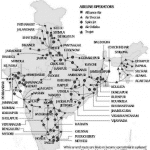TOPIC: Salient features of world’s physical geography.
- Meridians of longitudes are imaginary lines of reference running from the North to the South Pole.
- The distances between them are measured in ‘degrees on logitude’.
- They are semi-circles and the distance between them decreases steadily polewards until it becomes zero at the poles, where all the meridians meet.
- They are of equal lengths unlike latitudes.
- They are angular distance of a place from the Prime Meridian.
- For the sake of convenience, the longitude (imaginary line) passing through Greenwhich has been designated as the Prime Meridian= 0º.
- The Prime Meridian and the 180º meridian divide the Earth into halves, the Eastern Hemisphere and the Western Hemisphere.
- As the Earth rotates from west to east, those places east of Greenwhich will be ahead of Greenwhich time and those to the west will be behind it.
- The 180º longitude is also called as the International Date Line (IDL).
- The IDL passes through the Pacific Ocean. The time difference on either side of this line is 24 hours. So, the date changes as soon as the line is crossed. In order to avoid any confusion, it is drawn in a zig-zag manner so that it lies on the sea and not on the land. Else, different parts of the same island would have two different dates.
- Earth rotates 360º in 24 hours; 15º in 1 hour.
- This means, 1º in 4 minutes.
- As Earth rotates from west to east, if we move west of the IDL, one day is lost and if we move east of the IDL, one day is gained.
- Standard Meridian: Every country selects its standard meridian.
- The Indian Standard Meridian is at 82.5º East. The local time at this meridian is taken as the standard time for the whole country. It is 5.5 hours ahead of the Greenwhich Mean Time (GMT). So time in India will be GMT+ 5.5 hours ( since sun rises in the east ).
- Some countries have many time zones because of their greater longitudinal extent. For example, Russia and Canada.
- The Earth has been divided into 24 time zones of one hour each.
- Each zone covers 15º of longitude.
- Many countries also follow something called Daylight Savings Time. It involves advancing clocks to give evenings more daylight, compared to mornings. This is an annual adjustment, necessitated by difference in the number of hours of daylight available in winter and summer. It is not followed in India.
- In the USA, it means advancing the clocks by one hour and hence giving the evening an extra hour of daylight.
- The Prime Meridian passes through UK, France, Spain, Algeria, Mali, Burkina Faso, Ghana, Togo*.
- The IST line passes through Allahbad in UP, Madhya Pradesh, Bilaspur & Jagdalpur in Chattisgarh, Odisha and Andhra Pradesh.
Also read: Champaran Satyagraha
- *Capitals-
- UK- London
- France- Paris
- Algeria- Algiers
- Mali- Bamako
- Burkina Faso- Ouagadougou
-
Ghana- Accra
-
Togo- Lomé










